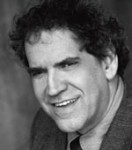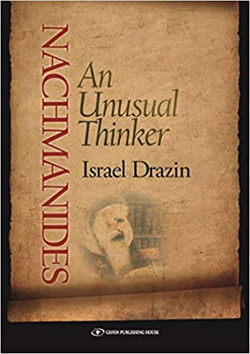Nachmanides: An Unusual Thinker by Rabbi Dr. Israel Drazin, Geffen Publishing House (c) 2018, ISBN 9789652-298874.
By Rabbi Michael Leo Samuel

 CHULA VISTA, California — One of the most interesting books I have read in years is Rabbi Israel Drazin’s excellent primer on the Ramban, entitled, Nachmanides An Unusual Thinker about a brilliant rabbinic scholar of the 13th century. He was born in Gerona in Northern Spain in 1194 and he was a man who had many remarkable experiences. And while he is best known for his biblical commentaries on the Pentateuch and other biblical books, Ramban is no less famous for his debate with the apostate Jew Pablo Christiani, which took place in 1263 in Barcelona before King James 1.
CHULA VISTA, California — One of the most interesting books I have read in years is Rabbi Israel Drazin’s excellent primer on the Ramban, entitled, Nachmanides An Unusual Thinker about a brilliant rabbinic scholar of the 13th century. He was born in Gerona in Northern Spain in 1194 and he was a man who had many remarkable experiences. And while he is best known for his biblical commentaries on the Pentateuch and other biblical books, Ramban is no less famous for his debate with the apostate Jew Pablo Christiani, which took place in 1263 in Barcelona before King James 1.
As Rabbi Drazin pointed out, Christiani attempted to prove to the community that the Sages “foreshadowed the birth and mission of Jesus.” And surprisingly, Nachmanides downplayed the significance of the midrashic texts, pointing out that these writings were only legends and should not be taken seriously. In rabbinical school, we studied this debate.
Rabbi Drazin noted:
Maimonides was a rationalist and his philosophy was expressed systematically and explicitly, open to thinkers in every generation, whereas the majority of Ramban’s basic ideas are rooted in the metalogical realm of the Kabbalah. Their manner of expression is the allusion, which only a select few were able to fathom throughout the generations.
What I liked about his book is how the author delineated many of the key conceptual differences that best characterize Ramban’s approach and how it contrasted with Maimonides. Think of it as the mystic vs. the rationalist. Being that Ramban was a mystic, his viewpoint tends toward a greater belief in supernatural events that are recorded in the Tanakh.
The author noted:
As a mystic, Nachmanides was the first person to introduce the idea that the Torah contains mystical notions, and the first to offer a mystical interpretation of the Bible. He was also the first to state that the Aramaic translation of the Pentateuch, Targum Onkelos, contains imaginative aggadic material and mysticism. It was as if he were arguing that if the Torah is true, and mysticism is true, and Targum Onkelos is true, then it follows that the Torah and Targum Onkelos must contain mysticism.
It is ironic that both Nachmanides and Maimonides share a common attribute in their exegetical styles: each one reads their personal Judaic philosophy into the biblical text. Unlike Maimonides, whose ideas fused elements of Greek and Muslim philosophy into his theological worldview, Ramban drew much of his inspiration from the area of Jewish tradition known as the Kabbalah—and this sphere of Jewish learning was one that Maimonides examined with the utmost of his intellectual criticism. According to Ramban, the midrashic hermeneutic constitutes the simple and literal sense of Scriptures, the entire Tanakh makes up the Name of God. Supernaturalism is the peshat of the Torah according to him. Nachmanides promotes the Torah as a mystical text— and this view has left a lasting impression on all subsequent Judaic mystics down to the present era.
As one of Maimonides’ foremost critics, Nachmanides challenged many of Maimonides’ philosophical expositions of how he interpreted familiar biblical narratives and laws. Being that Ramban was a mystic, he interpreted supernatural events as they were recorded in the Tanakh. He had no interest in Maimonidean rationalism.
Let us consider the following examples:
Unlike Maimonides’s parabolic approach to the Book of Genesis, Ramban takes the opposite position in keeping with his understanding of the peshat. For him, when the Torah speaks about an actual Garden of Eden and that Adam’s disobedience was a historical event that occurs in real time; Eden occupies an actual place in the ancient Near East. According to Maimonides—the story possesses a distinctively allegorical meaning. But for Ramban, the Edenic serpent was more than just a mythical character or a psychological symbol—it walks, and it talks too!
As R. Drazin observed:
“Nachmanides used the commentaries of Rashi and Abraham ibn Ezra, and less frequently Maimonides as a springboard with which to contrast his own original mystical biblical interpretation. He disagrees with these sages, often with strong disparaging words. He also cites the Aramaic translation of the Pentateuch, Targum Onkelos, but always with admiration, deference, and respect. Yet, although he mentions Onkelos 230 times in his commentary to the Pentateuch, generally to support” his point of view.
There are many interesting selections the author mentions. For example, he raises the questions:
· Do Animals Sin? Similarly, Genesis 6:12 states, “all flesh corrupted their ways.” Rashi argues that “all flesh” means that animals and birds also sinned. Nachmanides recognizes that animals do not sin and states that “all flesh” denotes “all people.”
· Why State Both “Created” and “Made”? Genesis 2:3 seems to have a duplication, “which God created, had made.” Ibn Ezra states that “had made” means that God gave the items the power to reproduce. Rashi opines that it suggests that God did double work on the sixth day. Nachmanides understands “had made” as suggesting, “that which He had made out of nothing.”
Similarly, later on in the Pentateuch, when Balaam’s donkey speaks, the story means exactly what it says. Once again, for Maimonides, he argued that in psychological terms, Balaam’s donkey can only be understood as a prophetic event; the Torah narrated a biblical character’s visionary experience. The theme of prophecy continues to be a bone of contention with Ramban, who differed with Maimonides’ view that the story about the three strangers who visit Abraham also occurred in a vision. Ramban, argues to the contrary, citing the detail given in the narrative occurs in real time. Abraham entertains real guests, not figments of his imagination. Beyond that, Ramban regarded all the midrashic stories mentioned in rabbinic tradition as having occurred.
Ramban also did not believe in the existence of “natural law” and that God is literally micromanaging all of His Creation, tweaking it from time to time. “God is constantly and directly involved in every human act and thought and frequently interferes and even controls them. He calls these divine manipulations ‘hidden miracles.’” This concept is fascinating, but Maimonides differed, arguing that God’s Providence over nature does not extend to a leaf falling from a tree, or whether every minor event operates with a special imperative from God.
Along the same line of thought, Ramban believed demons are the product of sorcery, and possess bodies composed of air and fire,[1] which enable them to take flight.[2] are familiar with future events because they communicate with the angels in charge of the stars.[3] More seriously, Ramban takes indirect aim at Maimonides by asserting anyone who does not believe in demonic beings suffers from a heretical attitude toward the world. According to Ramban, if you believe in miracles, then you ought to believe demonic beings exist as well. Elsewhere, Ramban writes:
It is from this standpoint that you can come to realize the ruthlessness and stubbornness of the principal Greek Philosopher Aristotle—may his name be erased from memory—who denies the truth of many things which we have seen and has been publicized throughout the world. In Mosaic times, these truths were known to all for the wisdom of that generation pertained to spiritual matters, e.g., entities involving the demonic and sorcery. However, when the Greeks arose, Aristotle believed only in what the physical sciences could confirm. In his effort to establish the scientific disciplines, he denied the realm of the spiritual. Aristotle denied the existence of demons and all magical acts. For him, the world operated solely by natural law. But it is well-known and shown that this is not the case at all. [4]
Maimonides considered such a perspective to be superstitious nonsense, and never does he endorse such a belief in demonology throughout all his writings, which are considerable.
The reader will find the material presented in this book fascinating. Nachmanides may not be necessarily correct in all of his claims, but as an expounder of the peshat (plain meaning of the text), readers will feel challenged to debate his position with other great ideas expressed by Rashi, Ibn Ezra, and other famous Judaic luminaries.
I really enjoyed reading Nachmanides: An Unusual Thinker, and I know you will too.
This book merits a 5 star rating from this reviewer.
NOTES:
[1] Ramban’s Commentary to Leviticus 17:7. Ramban’s description of demons is almost identical with the Muslim belief in Jinn (الجن, al-jinn) who are shape-shifting spirits composed of fire and air.
[2] Ibid.
[3] Ramban’s Commentary to Leviticus 17:7.
[4] Charles B. Chavel, Kitvei Ramban, “Derashat Torat Hashem Temimah,” vol. I, pp. 147, 149)
*
Rabbi Samuel is spiritual leader of Temple Beth Shalom in Chula Vista. He may be contacted via michael.samuel@sdjewishworld.com
Pingback: Rabbi Michael Leo Samuel